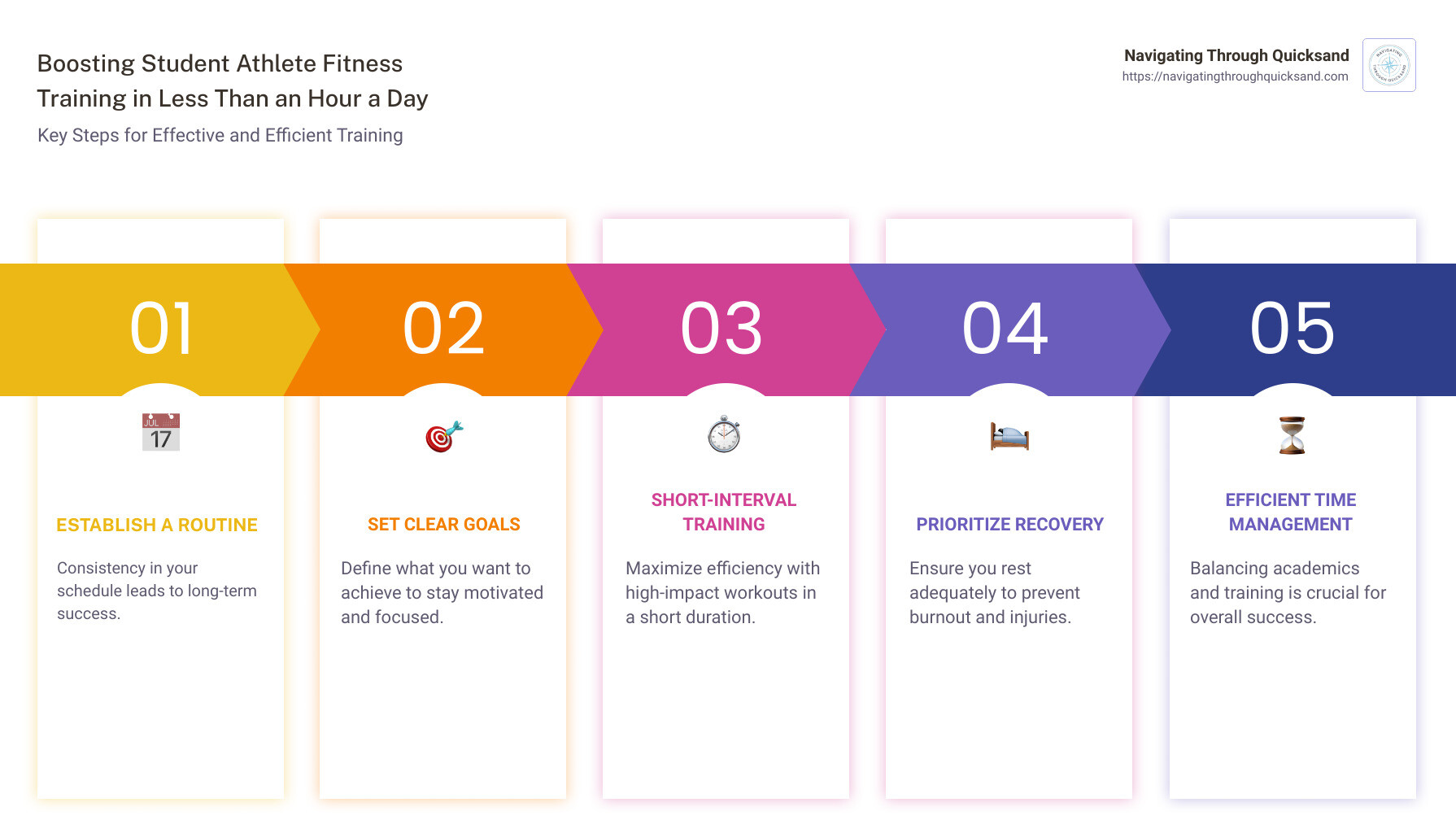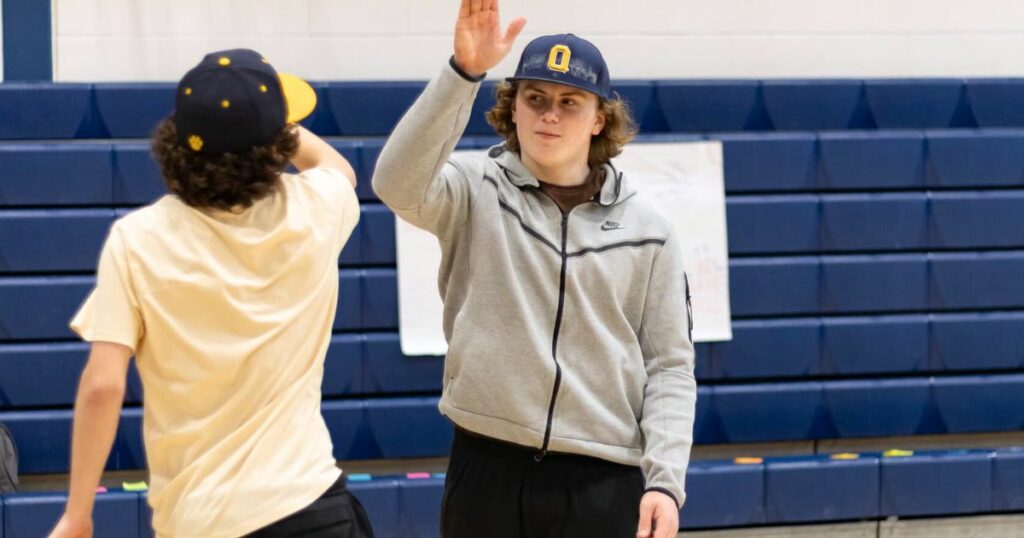Student athlete fitness training is the bedrock of athletic performance. Balancing academics and sports can be overwhelming, so knowing how to fit effective training into a busy schedule is invaluable.
Emphasizing fitness is crucial for student-athletes to excel both on and off the field. Proper training not only enhances athletic performance but also helps prevent injuries. Given their packed schedules, efficient time management is essential.
You don’t need hours every day. With the right techniques, even less than an hour can make a difference. In this guide, we’ll show you how.
4 Tips for Student Athlete Fitness Training
- Establish a Routine: Consistency is key.
- Set Clear Goals: Know what you want to achieve.
- Short-Interval Training: Maximize efficiency in less time.
- Prioritize Recovery: Avoid burnout with proper rest. Adequate sleep is essential for athletic performance, as sleep deprivation can significantly impact your ability to play at peak performance.

Table of Contents
Understanding the Basics of Student Athlete Fitness Training
Key Components of a Training Program
To create an effective student athlete fitness training program, understand its key components. These include individual assessment, fitness tests, gap analysis, and training frequency.
Individual Assessment: Start by evaluating the athlete’s current fitness level. This helps tailor the program to their specific needs. For instance, a strength and conditioning coach can assess areas like strength, endurance, agility, and flexibility.
Fitness Tests: Use standardized tests to measure performance and identify strengths and weaknesses. Common tests will measure for endurance, vertical jump for power, and agility drills for quickness.
Gap Analysis: Compare the athlete’s current abilities with the demands of their sport. This helps pinpoint areas that need improvement. For example, a soccer player might need to work on sprinting speed and leg strength.
Importance of Strength Training
Strength training is a cornerstone of any athletic program. It not only builds muscle but also prevents injuries and enhances overall performance. Additionally, strength training is essential for enhancing sports performance among young athletes.
Strength Exercises: Incorporate compound movements like squats, deadlifts, and bench presses. These exercises target multiple muscle groups and improve functional strength, which is crucial for athletic performance.
Muscle Building: Focus on progressive overload, which means gradually increasing the weight or resistance in workouts. This stimulates muscle growth and increases strength over time.
Injury Prevention: Strength training helps stabilize joints and improves muscle imbalances. This reduces the risk of common injuries like sprains and strains. According to D1 Training, their programs have helped over 100 NFL Draft Picks and 3,000 college athletes achieve their goals while minimizing injuries.
Incorporating these fundamentals into your training regimen ensures a balanced and effective approach to student athlete fitness. Next, we’ll delve into some effective training techniques to maximize results in less time.
Effective Training Techniques for Student Athletes

High-Intensity Interval Training (HIIT)
Interval Workouts: High-Intensity Interval Training (HIIT) is a powerful way to boost fitness in less time. By structuring your HIIT routine into a well-planned training session, alternating short bursts of intense activity with periods of rest, athletes can improve both speed and endurance. For example, you might sprint for 30 seconds, then walk for 30 seconds, and repeat. This method is efficient, making it perfect for students with tight schedules.
Cross Training: Incorporating different types of activities can prevent burnout and overuse injuries. Mixing strength training, aerobic exercises, and sport-specific drills keeps workouts interesting and comprehensive. For instance, a session might include rowing, push-ups, and agility drills.
Personalized Coaching: Tailored guidance can make a huge difference. Coaches can adjust HIIT routines to match an athlete’s specific needs, ensuring they get the most out of every session. This personalized approach helps in targeting weak areas and enhancing overall performance.
Sport-Specific Drills
Technical Skills: Practicing sport-specific drills helps athletes improve their in-game performance. For example, a soccer player might focus on dribbling and passing, while a basketball player works on shooting and defensive maneuvers. These drills hone the skills needed for success in actual games. Sport-specific drills are especially important for young athletes to develop their technical skills and build a strong foundation for future success.
In-Game Experiences: Simulating game scenarios during practice can prepare athletes mentally and physically for competition. This could involve scrimmages, mock plays, or situational drills that mimic real game conditions. Such exercises build agility and decision-making skills.
Agility Drills: Quick footwork and directional changes are crucial in many sports. Agility drills like ladder exercises, cone drills, and shuttle runs enhance an athlete’s ability to move swiftly and efficiently. These drills improve coordination and reaction time, essential for sports like football, basketball, and soccer.
Maximizing Training Efficiency

Sample 1-Hour Training Schedule
Time management is crucial for student athletes who need to balance academics and sports. A focused, efficient workout can be done in just one hour. Here’s a sample schedule:
Warm-Up (10 minutes):
- Dynamic stretches: Leg swings, arm circles, and hip rotations.
- Light cardio: Jogging or jumping jacks to get the blood flowing.
Main Workout (40 minutes):
- Strength Training (20 minutes):
- Compound exercises like squats, deadlifts, and bench presses. These exercises work multiple muscle groups and are highly effective.
- Short-interval strength training: 30 seconds of intense lifting followed by 15-30 seconds of rest. This method builds endurance and reduces overall workout time.
- HIIT (10 minutes):
- High-intensity interval training (HIIT) involves short bursts of intense activity followed by brief rest periods. For example, 20 seconds of sprinting followed by 10 seconds of walking. This boosts speed and endurance efficiently.
- Sport-Specific Drills (10 minutes):
- Tailor these to your sport. For example, agility drills for soccer or shooting drills for basketball. This keeps the workout relevant and engaging.
Cool-Down (10 minutes):
- Static stretches: Focus on major muscle groups to improve flexibility and prevent injury.
- Foam rolling: Helps release muscle tension and aids recovery.
Incorporating Recovery and Rehab
Recovery is as important as the workout itself. It prevents injuries and keeps you performing at your best.
Prehab (Prevention Habits):
- Stretching and Mobility Work: Incorporate daily stretching routines and mobility exercises to keep muscles flexible and joints healthy.
- Foam Rolling: Regular foam rolling can prevent muscle tightness and improve blood flow.
Rehab (Recovery Habits):
- Rest Days: Schedule at least one rest day per week to allow your body to recover.
- Injury-Specific Exercises: If you’re recovering from an injury, follow a rehab program designed by a professional. This might include specific stretches and strengthening exercises.
Injury Prevention:
- Proper Technique: Always use the correct form to avoid unnecessary strain and injuries.
- Balanced Routines: Ensure your training includes a mix of strength, endurance, and flexibility exercises. This balanced approach helps prevent overuse injuries and promotes overall fitness.
By maximizing training efficiency, student athletes can achieve their fitness goals without compromising their academic responsibilities. In the next section, we’ll discuss the importance of nutrition and hydration for optimal performance.
Nutrition and Hydration for Optimal Performance

Pre-Workout Nutrition
Fueling your body before a workout is like fueling a high-performance car. You need the right energy sources to perform at your best.
Meal Timing: Aim to eat a balanced meal 2-3 hours before your workout. This should include complex carbohydrates, lean proteins, and healthy fats. For example, a meal could be grilled chicken with brown rice and steamed vegetables.
Energy Sources: Complex carbohydrates, like whole grains and vegetables, provide a steady release of energy. Lean proteins, such as chicken or tofu, help repair and build muscles. Healthy fats from sources like avocados and nuts support overall health.
Supplements: While a balanced diet is the best way to get nutrients, some student athletes might benefit from supplements. Essential amino acids can be particularly useful for muscle recovery and performance. Always consult with a healthcare professional before starting any supplement.
Hydration Strategies: Drink water throughout the day, not just when you feel thirsty. Aim for at least 16-20 ounces of water in the two hours leading up to your workout. This helps ensure your muscles are hydrated and ready to perform.
Post-Workout Recovery
After a workout, your body needs nutrients to recover and rebuild. This is crucial for muscle recovery and overall performance.
Protein Intake: Consuming protein after a workout helps repair muscle tissues. Aim for 20-30 grams of protein within 30 minutes to an hour after exercising. Good sources include protein shakes, Greek yogurt, or a turkey sandwich.
Hydration: Rehydrate immediately after your workout. Water is essential, but you might also need electrolytes, especially after intense exercise.
Muscle Recovery: Incorporate foods rich in antioxidants, like berries and leafy greens, to help reduce inflammation and speed up recovery. Complex carbohydrates, such as sweet potatoes or quinoa, help replenish glycogen stores.
Meal Planning: Plan your meals to ensure you’re getting a balance of nutrients throughout the day. For example:
- Breakfast: Oatmeal with berries and a side of scrambled eggs.
- Lunch: Quinoa salad with mixed greens, chickpeas, and a light vinaigrette.
- Dinner: Salmon with sweet potato and steamed broccoli.
- Snacks: Greek yogurt with honey, or a handful of almonds and an apple.
By following these nutritional plans and hydration strategies, student athletes can maximize their performance and recovery. Proper nutrition and hydration are just as important as the workout itself.
Next, let’s dive into the frequently asked questions about student athlete fitness training
Conclusion
At Navigating Through Quicksand, we believe in a holistic approach to student athlete fitness training. Our goal is not just to improve physical performance but to foster lifelong benefits that extend beyond the playing field.
Holistic Approach
We understand that being a student athlete is about more than just physical prowess. It’s about balancing academics, athletics, and personal development. Our training programs are designed to build not only stronger athletes but also more resilient individuals. This approach helps student athletes develop discipline, time management skills, and mental toughness.
Lifelong Benefits
The lessons learned through our training programs go beyond sports. They shape character, build leadership skills, and instill a sense of dedication and perseverance. Whether you continue to play sports at a professional level or move into other fields, the habits and values developed through our training will serve you for life.
By focusing on a comprehensive training regimen that includes strength, endurance, flexibility, and recovery, we help student athletes achieve their full potential. Our programs are tailored to meet the specific needs of each athlete, ensuring they receive the most effective training possible.
Contact us today at Navigating Through Quicksand. We invite you to join us on this journey. Together, we can navigate through the quicksand of challenges and emerge stronger, more confident, and ready to take on whatever comes next.
Frequently Asked Questions about Student Athlete Fitness Training

How many hours a day do student athletes train?
Student athletes typically train anywhere from 1 to 3 hours a day depending on whether they are in-season or out of season.
- Out of season: Training focuses on building strength and honing technical skills. This can include 10-15 hours of practice per week, which breaks down to about 1.5-2 hours per day.
- In season: Training is more intense and can go up to 20 hours per week, or around 3 hours per day. This includes practice, lifting, and game simulations.
The intensity and duration of training can vary by sport and the athlete’s specific needs. For example, tennis players might focus on match play and agility drills during the season, while off-season training is more about strength and endurance.
How do you create an athlete training program?
Creating an effective athlete training program involves several steps:
- Individual Assessment: Start with fitness tests to understand the athlete’s current physical condition. This can include strength, endurance, flexibility, and agility assessments.
- Goal Setting: Define clear, achievable goals. Whether it’s improving speed, increasing strength, or refining technical skills, having specific targets helps in crafting a focused program.
- Customized Plan: Use the assessment and goals to develop a personalized training schedule. This should include a mix of:
- Strength Training: To build muscle and prevent injuries.
- High-Intensity Interval Training (HIIT): For speed and endurance.
- Sport-Specific Drills: To improve technical skills and simulate game scenarios.
- Recovery and Rehab: Incorporate prehab and rehab exercises to prevent injuries and aid recovery.
- Balanced Routine: Ensure the program balances intense workouts with adequate rest and recovery periods. This helps in avoiding burnout and injuries.
- Monitoring and Adjusting: Regularly review and adjust the program based on the athlete’s progress and any new goals or challenges.
Our Content
Our content is carefully created and edited by Ashley Gustafson to ensure that the content is accurate, reliable, and up-to-date. Navigating Through Quicksand, LLC is a trusted inspirational woman, inspirational speaker, and personal development coach in Massachusetts for confidence coaching programs for women such training sessions, athletic training for varsity teams, and more. Navigating Through Quicksand, LLC has empowered individuals with over 15 years of experience working with students and athletic teams from local communities.



